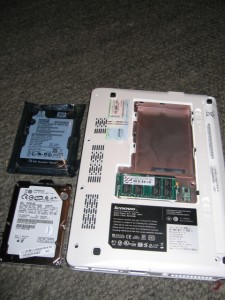by Stewart Vardaman
Disks get faster and better constantly, yet they are usually the slowest component in your notebook or PC. The simple truth is, memory speed might be measured in nanoseconds (billions), but disk speed is measured in milliseconds (thousands). That difference is like Bill Gates’s net worth to a working stiff like me.
Speeding up the slowest thing in the chain makes everything else faster. Adding a new disk to an old (or even new) laptop makes for a peppier machine. And you can do it yourself!
Here I have a new Lenovo Ideapad S10 Netbook. I purchased the model with the smallest hard drive because I planned on upgrading it immediately. The factory disk is 80 gig with an 8 meg cache and spins at 5400 rpm, and the replacement drive is 320 gig, 16 meg cache and 7200 rpm. The higher the spin speed, the faster the performance, and doubling the cache size helps too.
First, let’s get a benchmark on the original drive. It shipped with Windows XP, but to keep all variables constant, I benched it with a Linux Live CD’s hdparm utility:
Timing buffered disk reads: 170 MB in 3.01 seconds = 56.48 MB/sec
Laptop drives are often easier to replace than desktops. Most Dell and IBM/Lenovo models have the drive mounted in a tray on the front left side of the unit held in place by one or two screws (most IBMs have self-retaining flathead screws); in the case of this netbook, it’s on the bottom. Check the manufacturer’s Web site for specific removal instructions.
The tray (most all makes) has four side Phillips screws as shown by the red arrows. Mount the new drive in exactly the same position as the original, and return it to the laptop.
Let’s see what this puppy can do! Using the Live CD I formatted it as FAT32 (to match the factory file system) and ran hdparm again:
Timing buffered disk reads: 230 MB in 3.00 seconds = 76.54 MB/sec
That’s a nice speed increase of ~20% that you’ll particularly notice on boot-up times.
This upgrade works equally well for newer SATA laptops and also older ATA units such as the IBM T/X/A/ 2-4 series and Dell 600 series. It’s perfect for netbooks because by design they use the cheapest (and lowest-performing) disks.
Stewart Vardaman has been wearing a lot of hats in the IT business for over 20 years, and currently work as a web developer/Linux admin in the television industry.




{ 2 comments }
Footnote for Lenovo S10 owners:
In the photos you’ll see a 2 gig chip – that’s an after market install I did. Several sources claim the S10 can only support 1.5 gig of RAM, even Lenovo’s website.
Not true.
There is 512m on the motherboard, but that gets disabled when you put in a 2 gig chip. You get the full 2 gig, but unfortunately not 2.5 gig. 2 gig is the max no matter what configuration.
One more note – not all S10 models have Bluetooth built-in. Mine did not. I wasn’t paying attention and found out after I bought a slightly expensive Bluetooth laser mouse.
You can upgrade to internal Bluetooth by adding a little circuit board, on eBay for just under $20. That lets you run a real mouse, save a USB port, and not have a wireless mouse dongle hanging off your netbook.
Comments on this entry are closed.